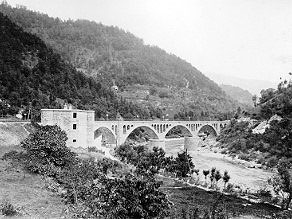The Ajba Viaduct
The railroad line first crosses the SoÄa River at the Ajba Viaduct. The first bridge was built of stone. Its central part with three 40-meter arches was supported by two stone piers with their foundations in the SoÄa River, and a third one on the right bank of the river. Here the bridge continued into a 30-meter arcade and ended on the left bank with two six-meter arches. At either end of the bridge, there were two stone fortresses to protect this beautiful and strategically important structure. Although the Ajba Viaduct was never as famous as the nearby Solkan Bridge, it was a unique construction achievement of its time. It was the longest railroad bridge across a water obstacle on Austro-Hungarian railroad lines, and at 252.5 meters it was the third-longest stone railroad bridge in the world.
Despite its defenses, the bridge was damaged twice. In 1915, during the First World War, the Austrians demolished the second large arch to prevent Italian troops from advancing. After the war, railroad traffic across the bridge was restored using a temporary iron structure. In 1925, the Italians finally renovated it and restored it to its original form. However, repeated shelling during the Second World War was fatal for the bridge. In 1944, English planes demolished the second renovated arch again. The shelling continued and, at the end of the war, this once magnificent and admired stone wonder was completely ruined. Immediately after the war, the English built an iron Roth-Waagner structure on the remaining piers, enabling provisional railroad traffic. In 1950, work began on a new concrete bridge with six 25-meter arches next to the old bridge. The new structure was built by SGP Primorje of AjdovÅ¡Äina. It was completed and officially opened to traffic in November 1954.






















 Previous
Previous Home
Home Next
Next